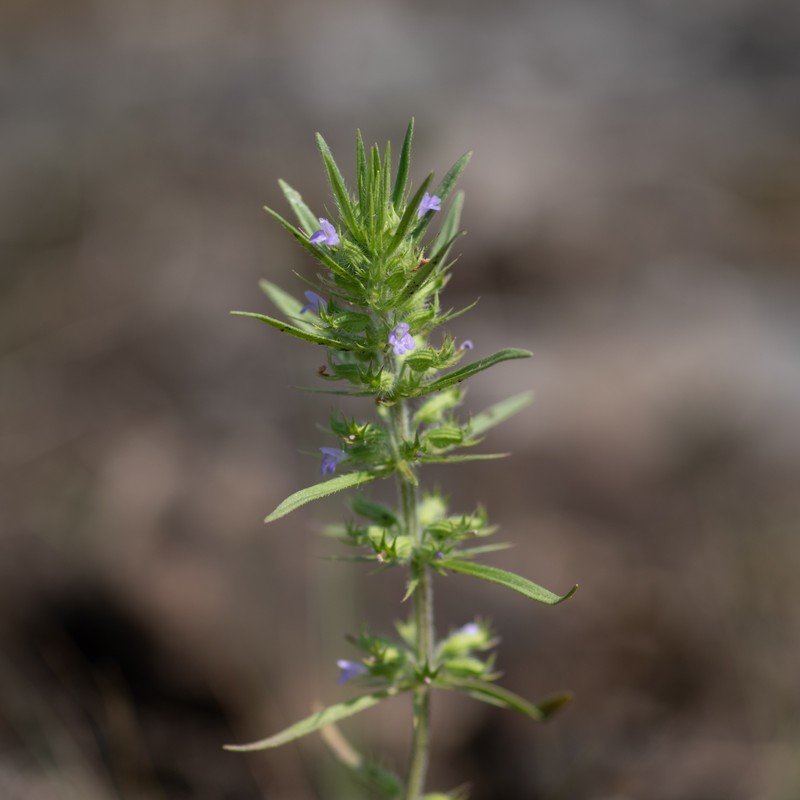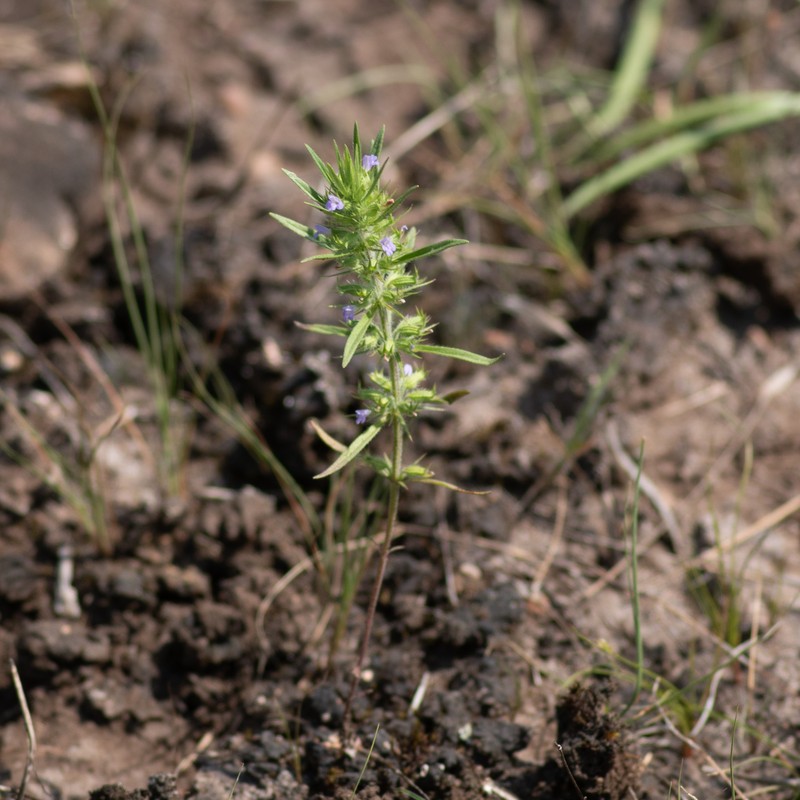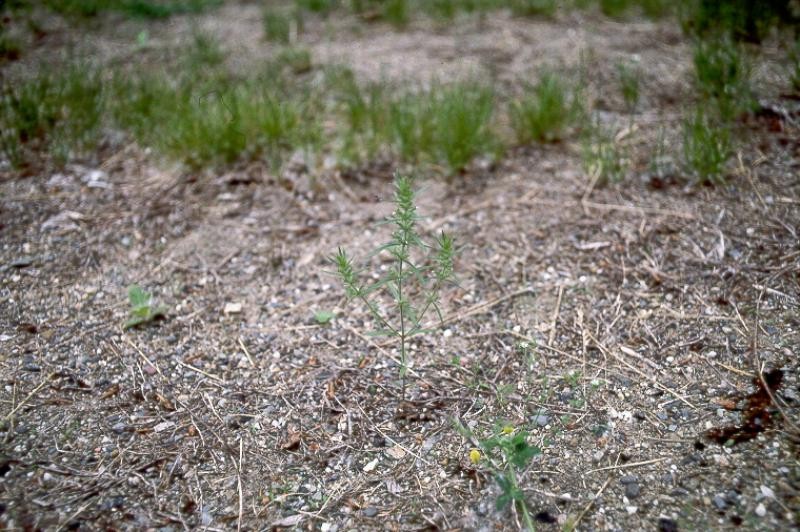Rough Pennyroyal
Hedeoma hispida Pursh
- Class
- Dicotyledoneae (Dicots)
- Family
- Lamiaceae (Mint Family)
- State Protection
- Threatened
Listed as Threatened by New York State: likely to become Endangered in the foreseeable future. For animals, taking, importation, transportation, or possession is prohibited, except under license or permit. For plants, removal or damage without the consent of the landowner is prohibited.
- Federal Protection
- Not Listed
- State Conservation Status Rank
- S2S3
Imperiled or Vulnerable in New York - Very vulnerable, or vulnerable, to disappearing from New York, due to rarity or other factors; typically 6 to 80 populations or locations in New York, few individuals, restricted range, few remaining acres (or miles of stream), and/or recent and widespread declines. More information is needed to assign either S2 or S3.
- Global Conservation Status Rank
- G5
Secure globally - Common in the world; widespread and abundant (but may be rare in some parts of its range).
Summary
Did you know?
The genus name Hedeoma comes from the greek word "hedyosmon", an ancient name for mint meaning sweet scent. The leaves and stem are hispid, meaning covered with short stiff hairs, thus the species name. This species is closely related to American pennyroyal, Hedeoma pulegioides, which had many medicinal and culinary uses. The Anglo/Norman word "puliol real" meaning Royal Pulegium or Royal Fleabane (pulex is latin for flea), was eventually changed into the modern word Pennyroyal.
State Ranking Justification
There are 11 existing populations but only three of these are large and protected. The remainder of the populations have less than 100 plants each. There are 17 historical occurrences and it is expected that with more surveys and a better understanding of habitat preference, many more populations could be found. Since this species is similar to the more common American pennyroyal it may be overlooked.
Short-term Trends
Only a few of the existing populations have been rechecked in recent years and their populations seem stable. Since the species occurs in disturbed areas short-term trends probably vary widely as disturbance changes.
Long-term Trends
The overall abundance of sites has remained about the same over the last 100 years but plants have disappeared in grazed areas as succession has taken over. This species has appeared in other human disturbed areas such as roadsides but not to the extent that it has been found to be common.
Conservation and Management
Threats
The open habitat of this species may be threatened by succession if the area is not kept open but at the same time plants may be killed by direct impact from mowers, bulldozers and ATVs.
Conservation Strategies and Management Practices
Disturbed areas need to be maintained without directly damaging plants. This can be done by mowing at the appropriate time of year after seed has been disbursed.
Research Needs
Research is needed to understand habitat preference and why this species is found in common disturbed habitats but is not abundant in all of them. What is its limiting factor?
Habitat
Habitat
In New York Mock-pennyroyal has been found at a wide variety of open, dry sites. While some of these habitats are calcareous to circumneutral, such as red-cedar rocky summits, rich talus slopes, and alvar grasslands, there are also healthy populations at mowed airport aprons, dunes, and disturbances within pitch-pine plains (New York Natural Heritage Program 2007). Dry soil, sand dunes, and barrens (Gleason and Cronquist 1991). Plains, sands and rocky banks (Fernald 1970).
Associated Ecological Communities
- Alvar pavement grassland
(guide)
This community consists of exposed, flat limestone or dolostone pavement with grassy or mossy patches interspersed throughout. Some examples may be solely grassland with no pavement.
- Calcareous talus slope woodland*
(guide)
An open or closed canopy community that occurs on talus slopes composed of calcareous bedrock such as limestone or dolomite. The soils are usually moist and loamy; there may be numerous rock outcrops.
- Mowed lawn
Residential, recreational, or commercial land, or unpaved airport runways in which the groundcover is dominated by clipped grasses and there is less than 30% cover of trees. Ornamental and/or native shrubs may be present, usually with less than 50% cover. The groundcover is maintained by mowing and broadleaf herbicide application.
- Mowed roadside/pathway
A narrow strip of mowed vegetation along the side of a road, or a mowed pathway through taller vegetation (e.g., meadows, old fields, woodlands, forests), or along utility right-of-way corridors (e.g., power lines, telephone lines, gas pipelines). The vegetation in these mowed strips and paths may be dominated by grasses, sedges, and rushes; or it may be dominated by forbs, vines, and low shrubs that can tolerate infrequent mowing.
- Red cedar rocky summit
(guide)
A community that occurs on warm, dry, rocky ridgetops and summits where the bedrock is calcareous (such as limestone or dolomite, but also marble, amphibolite, and calcsilicate rock), and the soils are more or less calcareous. The vegetation may be sparse or patchy, with numerous lichen covered rock outcrops.
- Successional northern sandplain grassland*
(guide)
A meadow community that occurs on open sandplains that have been cleared and plowed (for farming or development), and then abandoned. This community is usually dominated by low, dry turf of sedges and grasses less than 30 cm (12 inches) tall, and include patches of open sand and patches of soil covered with mosses and lichens.
* probable association but not confirmed.
Associated Species
- Arabidopsis lyrata
- Arenaria serpyllifolia (thyme-leaved sandwort)
- Campanula rotundifolia (hare-bell)
- Cardamine parviflora (small-flowered bitter cress)
- Carex aurea (golden-fruited sedge)
- Carex crawei (Crawe's sedge)
- Carex granularis (limestone-meadow sedge)
- Carya ovata
- Cerastium arvense (field chickweed)
- Draba reptans
- Draba verna (spring whitlow-grass)
- Fraxinus americana (white ash)
- Lupinus perennis
- Packera paupercula (balsam groundsel)
- Pilosella caespitosa (yellow hawkweed)
- Plantago
- Prunus serotina
- Prunus virginiana
- Quercus alba (white oak)
- Quercus ilicifolia (scrub oak, bear oak)
- Ranunculus micranthus (small-flowered butter-cup, small-flowered crow-foot)
- Saxifraga virginiensis
- Schizachyrium scoparium
- Scutellaria parvula
- Silene caroliniana
- Verbascum thapsus (common mullein)
- Viburnum rafinesquianum
Range
New York State Distribution
This species occurs at scattered locations throughout eastern New York from Long Island to the St. Lawrence Valley.
Global Distribution
Mock-pennyroyal is found in most of the U.S. from the Rockies east (excluding Maine, New Jersey, Delaware, and the Carolinas), and across Canada from Quebec to British Columbia.
Identification Comments
General Description
Hedeoma hispida is a small, annual, aromatic herb of the mint family, from 1 to 4 dm tall. The stems are finely hairy and the leaves are opposite, linear, 1-2 cm long, and entire. The flowers are purplish-blue, up to 5mm long, and emerge in fours from each leaf axil. The sepals are covered in long hairs, and their upper halves are divided into awl-shaped teeth.
Best Life Stage for Proper Identification
Mock-pennyroyal is best identified when flowering or fruiting.
Similar Species
Hedeoma pulegioides is more likely found in wooded habitat, and has broader, often serrate leaves and triangular calyx lobes.
Best Time to See
False pennyroyal flowers in June and July, the fruits persisting into August.
- Flowering
- Fruiting
The time of year you would expect to find Rough Pennyroyal flowering and fruiting in New York.
Rough Pennyroyal Images
Taxonomy
Rough Pennyroyal
Hedeoma hispida Pursh
- Kingdom Plantae
- Phylum Anthophyta
- Class Dicotyledoneae
(Dicots)
- Order Lamiales
- Family Lamiaceae (Mint Family)
- Order Lamiales
- Class Dicotyledoneae
(Dicots)
- Phylum Anthophyta
Synonyms
- Hedeoma hispidum Pursh
Additional Resources
Best Identification Reference
Gleason, Henry A. and A. Cronquist. 1991. Manual of Vascular Plants of Northeastern United States and Adjacent Canada. The New York Botanical Garden, Bronx, New York. 910 pp.
Other References
Fernald, M.L. 1950. Gray's manual of botany. 8th edition. D. Van Nostrand, New York. 1632 pp.
Haines, Arthur and Thomas F. Vining. 1998. Flora of Maine. A Manual for Identification of Native and Naturalized Vascular Plants of Maine.
Holmgren, Noel. 1998. The Illustrated Companion to Gleason and Cronquist's Manual. Illustrations of the Vascular Plants of Northeastern United States and Adjacent Canada. The New York Botanical Garden, Bronx, New York.
New York Natural Heritage Program. 2010. Biotics database. New York Natural Heritage Program. New York State Department of Environmental Conservation. Albany, NY.
New York Natural Heritage Program. 2024. New York Natural Heritage Program Databases. Albany, NY.
Rhoads, Ann F. and Timothy A. Block. 2000. The Plants of Pennsylvania, an Illustrated Manual. University of Pennsylvania Press, Philadelphia, PA.
Voss, Edward G. 1996. Michigan Flora Part III. Dicots Concluded (Pyrolaceae - Compositae). Cranbrook Institute of Science Bulletin 61 and University of Michigan Herbarium. 622 pp.
Weldy, T. and D. Werier. 2010. New York flora atlas. [S.M. Landry, K.N. Campbell, and L.D. Mabe (original application development), Florida Center for Community Design and Research http://www.fccdr.usf.edu/. University of South Florida http://www.usf.edu/]. New York Flora Association http://newyork.plantatlas.usf.edu/, Albany, New York
Weldy, Troy W. and David Werier. 2005. New York Flora Atlas. [S.M. Landry, K.N. Campbell, and L.D. Mabe (original application development), Florida Center for Community Design and Research. University of South Florida]. New York Flora Association, Albany, NY. Available on the web at (http://newyork.plantatlas.usf.edu/).
Links
About This Guide
Information for this guide was last updated on: February 1, 2023
Please cite this page as:
New York Natural Heritage Program. 2024.
Online Conservation Guide for
Hedeoma hispida.
Available from: https://guides.nynhp.org/rough-pennyroyal/.
Accessed July 27, 2024.


